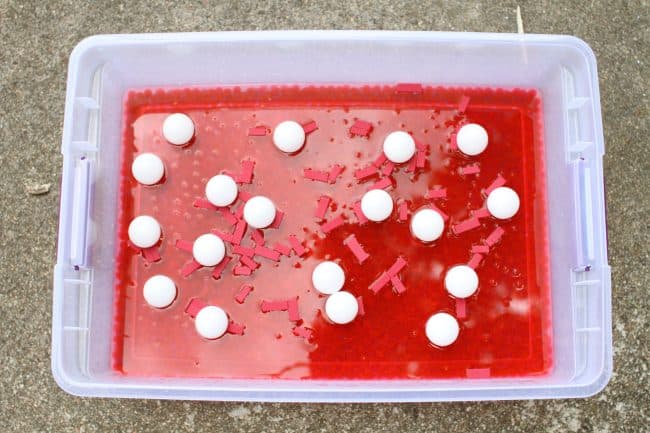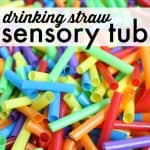What is blood made of?

What is blood?
Blood has become a familiar sight in our household these days. Whether it is a scraped knee or bloody nose (from intense allergy issues), blood is quite intriguing to our boys. After one of our recent encounters with blood, Big Brother asked the question, “What is blood made of?”
We checked out some library books on the human body and began our research. I have used water beads in sensory tubs before and immediately knew the perfect way to demonstrate the various parts of blood in a fun and hands-on way!
*Please note: This activity is not suitable for children under the age of 3. Please be careful with younger siblings as the water beads can be a choking hazard.
Parts of Blood Activity
Here’s what you’ll need:
- a large plastic container (or sensory tub)
- red water beads
- ping-pong balls (super cheap on Amazon)
- water
- red craft foam
Blood Activity Instructions:
Step 1. Follow the instructions on the packaging to hydrate the red water beads. Go ahead and put them (and the water) into your plastic tub / sensory table to soak. Our package instructions indicated that once you add the water, it takes 10 hours for them to fully hydrate.
STEP 2. Cut the craft foam into small pieces to create your platelets.
STEP 3. Put the “platelets” and several ping pong balls in your plastic tub of blood.
STEP 4. Let your kids explore the “blood” for a while and then talk with them about the parts of blood:
Red water beads = Red Blood Cells (that carry oxygen)
Ping Pong Balls = White Blood Cells (that fight germs, bacteria, and viruses)
Craft Foam Pieces = Platelets (that help heal cuts)
Water = Plasma (helps the blood move through veins and arteries)
This was a huge hit for the boys…and they were able to give Daddy a full synopsis once he came home from work!
From the book: The Human Body
From the book: Body: An Amazing Tour of Human Anatomy
This post was first published June 2014. Updated 2018.
Overall, a great learning experience for us all! What is your favorite science activity?
Click here for more about the human body:
Anatomy Books for Kids & Toddlers
Why the Human Body Needs Both Muscles & Bones
Human Body Preschool Activities
Fun Body Parts Song for Toddlers
















This is fantastic! Thanks for sharing. I cannot wait to do this with my little man.
Im a 5th grader and its interesting
So glad you liked the idea! Thanks Alina! :)
im in 7th grade I love boiology this is cool
This is a great idea! For a fun treat you could reinforce the same concept by making Kool-Aid: cherry crystals (red blood cells), sugar (white blood cells), ice cubes (platelets), and water (plasma.)
That’s a great idea!
This is one of the coolest ways to teach children about blood that I’ve seen! Love it! Great idea.
Thanks so much, Janine! :)
I love this very much! I’ve definitely pinned for a future homeschool activity once we get there (and my child is older), but what a fantastic way to teach children about blood! It looks so inviting and not ‘scary’ or ‘icky’!
This is pure awesomeness! So creative – I love it! Pinning this to use with my kids when the time comes!
Thanks so much!
Fascinating!! What a creative way to learn about blood. So cool!
Thank you! :)
I love that you came up with a way to study blood that is on a large scale and that removes the gross factor for kids! Pinned for later.
I love anything hands on! We are studying the human body next year and this is so fun! Thank you! Pinning this!
LOVE this!
Thanks for the idea,this is a great idea for my son who is blind. For him everything is hands on a nod this will help me explain blood to him. Thank you!
I am a retired science teacher. I used candy in salad oil. Candy: white jelly beans (white blood cells), red hots (red blood cells), candy sprinkles (platelets). The salad oil is the plasma. Make sure your ratio is reasonably correct.
That is a great idea! Thanks Martha! :)
P.S. Your platelets are too big.
This is such a wonderful idea. I don’t think *specific* size and ratio matter, this is clearly an activity for little kids… little kids don’t need things to be literal. Especially considering they have images in their science books to refer to :)
Where can you buy red water beads? Are they sold in stores like Super Target or a specialty store or do I have to order online? I ask because I just read to my kids about blood in our science book and don’t want to wait four days to receive them to do this with my kids, it looks that fun!! ha
You should be able to buy them at craft stores (in the floral department), but there is also a link in the post to where I purchased them (on Amazon). :)
I created this model for my second graders and also took it to our Math and Science night. The students had so much fun “feeling” the contents of their blood. They will never forget it either! Thanks for sharing :)
Yay! So glad they enjoyed it! We did this last summer and my boys STILL talk about it! :)
I love this idea for teaching younger children! I’m thinking about doing this for my little preschoolers. Do you know approximately how long it took for the water beads to fill up? I want to have it prepared and ready to go, you know how impatient kids can get.
My package says it takes 10 HOURS for the water beads to fully hydrate, so I would definitely do that the evening before so they are ready to go the next day. :)
Hi there can you tell me how many packages of the beads you used – we have 10g packets and I am not sure how many we need to fill a tub.
I didn’t even use an entire packet…just a couple tablespoons. I think you use 1 tablespoon per 10 cups of water, so they expand quite a bit!
Platelets are actually the fragmented bits of a huge cell — maybe instead of little rectangles you could cut circles into little piece
Good idea! :)
Thanks for such a great idea! We made this bin today with two small changes – we couldn’t find cheap ping pong balls, so we used the hollow plastic “practice” golf balls instead ($2 for a dozen) and we cut small discs out of pink foam to be our platelets. My daughter brought down some of her dollhouse dolls so she could recreate scenes from the Magic School Bus! :)
Awesome!!! So glad you enjoyed it! Those sound like excellent modifications. :)
I came across this on pinterest and love the idea! Having an 8 year old, a 4 year old, and a 2 year old I love something they all can enjoy. I was thinking about making this safe (aka edible) for my 2 year old by using red tapioca pearls (red blood cells), twizzlers (platelets), and marshmallows (white blood cells).
Thanks so much! The tapioca pearls would be a great modification and I like your other ideas too!
Thank you so much for this. It is such a great way to illustrate the concept and parts of blood. I am fascinated and I’m pushing 50! Love this so much. Adding the books is a great way for kids to learn how to find their own answers. I’ve shared this on my Facebook.
Hi! This is an amazing idea….I am a transfusion medicine physician and I volunteered to speak to my son’s first grade class about what I do. We are going to make this awesome blood. I have one question: I purchased the same red water beads (also from Amazon)…mine are very pale when they are hydrated (I tried a couple to see how they would look). Yours seem much darker than mine….did you color the water you hydrated them? with food coloring? I have never used them before. Thanks!
I’m so glad you like this idea! On their own, they are pretty pale, but when you put them all together they should be relatively dark just like the photos. The more beads you use, the darker the overall color will be. You can always add some food coloring (or liquid watercolors) if necessary, but I doubt you will need to once you get enough beads. :)
Love this idea. I work with latch key kids. Kindergarten through second grade.
Pure genius!!!!! I could have used this idea in Kindergarten. Now it’s too late, I’m retired.
This idea is very useful to me. I am a student teacher and going to demo teach about blood and its components I am surfing in the internet for some activities about blood before we start to the lesson proper. It really helped me a lot since the materials are cheaper and easy to find.
Thank you so much!
This is an amazing idea. Thank you
I saw this idea and pinned it for a homeschool lesson over a year ago, and I’m FINALLY getting to use it. Thanks so much for the great illustration of the parts of blood. This human body unit is going to be awesome.
I LOVED this idea! We were doing a unit for 3 – 6 year olds on the human body (you can see all our activities here: https://inventorsoftomorrow.com/2018/03/13/anatomy-for-kids/), and we did this in the water table. We used white pompoms for the platelets as those are closer in appearance to real platelets, and colored the water yellow to represent plasma. We also added some pumps to be “the heart”.
I just did this with our homeschool co-op but substituted little pieces of cut up gauze for the platelets instead of foam. With that substitution I was able to demonstrate how when cut, the platelets stick together to form a plug which catch the red blood cells. The red blood cells can be strained through gauze and smooshed to form a jelly like clot which then dries to make a scab.
This is great idea!